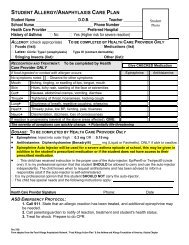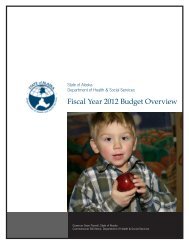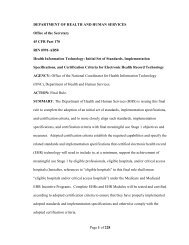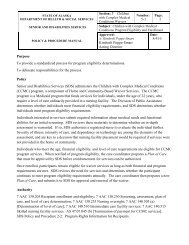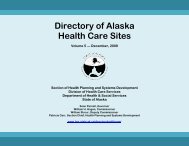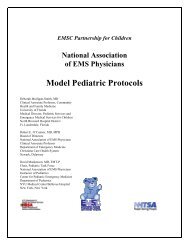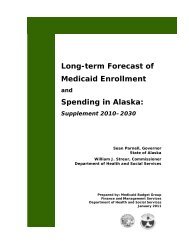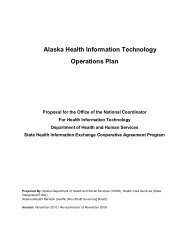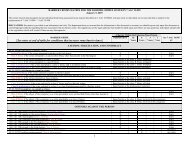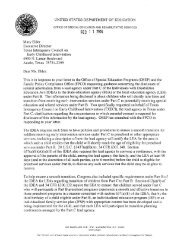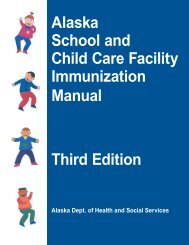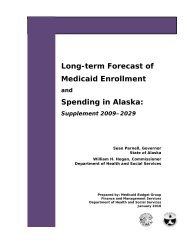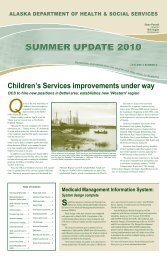2011-2012 Annual Report - Alaska Department of Health and Social ...
2011-2012 Annual Report - Alaska Department of Health and Social ...
2011-2012 Annual Report - Alaska Department of Health and Social ...
Create successful ePaper yourself
Turn your PDF publications into a flip-book with our unique Google optimized e-Paper software.
Casting the Net<br />
Upstream<br />
<strong>Alaska</strong><br />
Statewide Suicide<br />
Prevention Council<br />
FY<strong>2011</strong>-FY<strong>2012</strong><br />
<strong>Annual</strong> <strong>Report</strong>s<br />
Page 1
Governor Sean Parnell<br />
State <strong>of</strong> <strong>Alaska</strong><br />
Commissioner William Streur<br />
<strong>Department</strong> <strong>of</strong> <strong>Health</strong> & <strong>Social</strong> Services<br />
Chairman William Martin (<strong>Alaska</strong> Federation <strong>of</strong> Natives) Vice-Chair Meghan Crow, LCSW (Secondary Schools)<br />
Teressa Baldwin (Youth) Lowell Sage, Jr. (Clergy)<br />
Phyllis Carlson (DEED) Melissa Stone (DHSS)<br />
Barbara Jean Franks (Suicide Loss Survivor) Sharon Strutz-Norton (Public)<br />
Alana Humphrey (Statewide Youth Organization) Senator Fred Dyson (Legislature)<br />
Brenda Moore, (AMHB) Senator Johnny Ellis (Legislature)<br />
Christine Moses (Rural <strong>Alaska</strong>) Representative Anna Fairclough (Legislature)<br />
Anna Sappah (ABADA) Representative Berta Gardner (Legislature)<br />
J. Kate Burkhart, Executive Director Eric Morrison, Council Assistant<br />
May, <strong>2012</strong><br />
Page 2
Introduction<br />
The Statewide Suicide Prevention Council was established by the <strong>Alaska</strong> Legislature in 2001 <strong>and</strong><br />
extended by the Legislature to June 30, 2013. The Council is responsible for advising legislators <strong>and</strong> the<br />
Governor on ways to improve <strong>Alaska</strong>ns’ health <strong>and</strong> wellness by reducing suicide, improving public<br />
awareness <strong>of</strong> suicide <strong>and</strong> risk factors, enhancing suicide prevention efforts, working with partners <strong>and</strong><br />
faith-based organizations to develop healthier communities, creating a statewide suicide prevention<br />
plan <strong>and</strong> putting it in action, <strong>and</strong> building <strong>and</strong> strengthening partnerships to prevent suicide. 1<br />
Each year, the Council provides an annual report on its activities <strong>and</strong> the<br />
impact <strong>of</strong> suicide prevention efforts over the past year. The FY<strong>2011</strong>-<strong>2012</strong><br />
reports take their title from the five-year state suicide prevention plan<br />
created <strong>and</strong> implemented over the past two years – Casting the Net<br />
Upstream: Promoting Wellness to Prevent Suicide. 2<br />
This report is different from the comprehensive data <strong>and</strong> suicide<br />
prevention system review provided in the FY2010 <strong>Annual</strong> <strong>Report</strong>. This<br />
report’s focus is the work <strong>of</strong> the Council over the past two years. The<br />
majority <strong>of</strong> Council activities in FY<strong>2011</strong> involved development <strong>of</strong> the<br />
<strong>2012</strong>-2017 state suicide prevention plan. In FY<strong>2012</strong>, the Council finalized<br />
the plan <strong>and</strong> commenced implementation.<br />
1 AS 44.29.350. The Council’s statutory authority is included in Appendix A.<br />
2 The plan is available online at http://www.hss.state.ak.us/suicideprevention/pdfs_sspc/SSPC_<strong>2012</strong>-2017.pdf.<br />
Page 3
Incidence <strong>of</strong> Suicide<br />
<strong>Alaska</strong> continues to have a suicide rate twice the national average. In 2010, the age-adjusted rate was<br />
23/100,000. 3 The actual number <strong>of</strong> lives lost to suicide in 2010 was 163. 4<br />
A look at the age-adjusted rates over time helps provide a better picture <strong>of</strong> how <strong>Alaska</strong>n communities<br />
are affected by suicide.<br />
90.0<br />
80.0<br />
70.0<br />
60.0<br />
50.0<br />
40.0<br />
30.0<br />
20.0<br />
10.0<br />
0.0<br />
3 Data provided by the <strong>Alaska</strong> Bureau <strong>of</strong> Vital Statistics.<br />
4 Data provided by the <strong>Alaska</strong> Bureau <strong>of</strong> Vital Statistics.<br />
<strong>Alaska</strong> Age Adjusted Suicide Rates by<br />
Region 2001-2010<br />
2001 2002 2003 2004 2005 2006 2007 2008 2009 2010<br />
Source: <strong>Alaska</strong> Bureau <strong>of</strong> Vital Statistics (January 19, <strong>2012</strong>)<br />
Anchorage<br />
Gulf Coast<br />
Interior<br />
Mat-Su<br />
Northern<br />
Southeast<br />
Southwest<br />
Page 4
It is important to note that the story behind suicide rates is not the same as the story behind suicide<br />
numbers. <strong>Alaska</strong>’s rural regions have the highest rates <strong>of</strong> suicide, because the population <strong>of</strong> most<br />
communities is small. One suicide in a small community has not only a huge emotional <strong>and</strong> social<br />
impact, but also affects the statistical rates <strong>of</strong> the community <strong>and</strong> region. <strong>Alaska</strong>’s largest metropolitan<br />
area, Anchorage-Wasilla-Palmer, has had the highest number <strong>of</strong> suicides for several years. The statistical<br />
impact may not be as great, due the concentrated population, but the loss to families <strong>and</strong> communities is<br />
still substantial.<br />
<strong>Alaska</strong>n men continue to have a higher incidence <strong>of</strong> suicide, while suicide rates for <strong>Alaska</strong>n women<br />
remain relatively flat.<br />
40<br />
30<br />
20<br />
10<br />
0<br />
<strong>Alaska</strong> Age Adjusted Suicide Rates<br />
by Gender 2001-2010<br />
2001 2002 2003 2004 2005 2006 2007 2008 2009 2010<br />
Source: <strong>Alaska</strong> Bureau <strong>of</strong> Vital Statistics (January 19, <strong>2012</strong>)<br />
Male<br />
Female<br />
Page 5
<strong>Alaska</strong>n youth continue to show higher rates <strong>of</strong> suicide than other age groups. In 2010, the rate for youth<br />
age 15-24 was 46/100,000. 5 For adults over age 25, the rate dropped significant to a range <strong>of</strong> 24.4-28.1 per<br />
100,000. 6<br />
Suicide attempts occur at a higher rate than completed suicides. In 2007 (the most recent year’s data<br />
available from the <strong>Alaska</strong> Trauma Registry), the suicide attempt rate was 99.3/100,000 people. 7 More<br />
recent data from the <strong>2011</strong> Youth Risk Behavior Survey shows that, among high school students<br />
surveyed, 14.5-21.2% <strong>of</strong> students reported considering suicide in the past year <strong>and</strong> 8.7-13.2% reported<br />
attempting suicide in the past year. 8<br />
Risk Factors for Suicide<br />
Suicide is the result <strong>of</strong> a complex confluence <strong>of</strong> events <strong>and</strong> experiences. The “web <strong>of</strong> causality” must be<br />
recognized in order for prevention efforts to be effective.<br />
There are many warning signs <strong>and</strong> risk factors that can indicate that someone is at risk <strong>of</strong> suicide. Not<br />
every person will present with the same signs, but there are common indications <strong>of</strong> risk that can help in<br />
identifying when someone is at risk <strong>and</strong> intervening to prevent suicide.<br />
5 Data provided by the <strong>Alaska</strong> Bureau <strong>of</strong> Vital Statistics.<br />
6 Data provided by the <strong>Alaska</strong> Bureau <strong>of</strong> Vital Statistics. This range does not include the rate for age groups in which there<br />
were fewer than 20 suicides (ages 35-44 <strong>and</strong> ages 65-74).<br />
7 Data provided by the <strong>Alaska</strong> Trauma Registry, Division <strong>of</strong> Public <strong>Health</strong>.<br />
8 <strong>2011</strong> <strong>Alaska</strong> Youth Risk Behavior Survey Highlights (DHSS), comparing traditional <strong>and</strong> alternative high school students<br />
surveyed, at 2.<br />
Page 6
Risk factors for suicide include:<br />
Depression or other mental illness;<br />
A suicide attempt in the past;<br />
Having been exposed to the suicide <strong>of</strong> another person;<br />
Needing but not receiving mental health care;<br />
Increasing use <strong>of</strong> drugs or alcohol, including binge drinking; <strong>and</strong><br />
Access to a firearm or other means in the home. 9<br />
Warning signs for suicide include:<br />
Talking about wanting to die or to kill oneself;<br />
Looking for a way to kill oneself, such as searching online or buying a gun;<br />
Talking about feeling hopeless or having no reason to live;<br />
Talking about feeling trapped or in unbearable pain;<br />
Talking about being a burden to others;<br />
New or increased use <strong>of</strong> alcohol or drugs;<br />
Acting anxious or agitated;<br />
Behaving recklessly or taking more risks than usual;<br />
Sleeping too little or too much;<br />
Displaying extreme mood swings or changes in mood (whether happier or sadder). 10<br />
9 Information provided by the American Association <strong>of</strong> Suicidology, www.suicidology.org.<br />
10 Information provided by the National Suicide Prevention Lifeline.<br />
ALASKA CARELINE<br />
Page 7
A history <strong>of</strong> adverse childhood experiences can also contribute to risk for suicide. Adverse childhood<br />
experiences include child abuse <strong>and</strong> neglect, parental mental illness, parental substance abuse, death <strong>of</strong><br />
a parent, incarceration <strong>of</strong> a parent, <strong>and</strong> other traumatic events. 11<br />
Extensive research has been conducted on the mental <strong>and</strong> physical consequences <strong>of</strong> adverse childhood<br />
experiences. 12 A link has been documented between adverse childhood experiences <strong>and</strong> suicide, with<br />
the risk for suicide increasing by two (2) to five (5) times, regardless <strong>of</strong> the nature <strong>of</strong> the adverse<br />
childhood experience that occurred. 13<br />
Adverse childhood experiences also increase the risk for mental <strong>and</strong> physical health problems that<br />
contribute to the web <strong>of</strong> causality for suicide. Research has shown a link between multiple adverse<br />
childhood experiences <strong>and</strong> substance abuse <strong>and</strong> addiction, depression, risk for intimate partner violence<br />
(domestic violence), <strong>and</strong> risky sexual behaviors. 14<br />
11 A complete list <strong>of</strong> adverse childhood experiences is available at http://www.cdc.gov/ace/prevalence.htm#ACED.<br />
12 The Centers for Disease Control <strong>and</strong> Prevention provide information about the original study as well as subsequent<br />
research into adverse childhood experiences at http://www.cdc.gov/ace/index.htm.<br />
13 Childhood Abuse, Household Dysfunction, <strong>and</strong> the Risk <strong>of</strong> Attempted Suicide Throughout the Life Span: Findings From the<br />
Adverse Childhood Experiences Study, Shanta R. Dube, MPH et al., Journal <strong>of</strong> the American Medical Association (2001;<br />
286(24):3089-3096).<br />
14 For an overview <strong>of</strong> the findings from the ACE Study, see Relationship <strong>of</strong> Childhood Abuse <strong>and</strong> Household Dysfunction to<br />
Many <strong>of</strong> the Leading Causes <strong>of</strong> Death in Adults: The Adverse Childhood Experiences (ACE) Study, Felitti VJ, et al., American<br />
Journal <strong>of</strong> Preventative Medicine (1998 May; 14(4):245-58). A bibliography <strong>of</strong> published research on adverse childhood<br />
experiences <strong>and</strong> health outcomes is available from the Centers for Disease Control <strong>and</strong> Prevention online at<br />
http://www.cdc.gov/ace/outcomes.htm.<br />
Page 8
Creating the State Suicide Prevention Plan<br />
15 See A.S.44.29.350(5).<br />
The Council is responsible for developing the state plan to<br />
guide <strong>Alaska</strong>’s suicide prevention efforts. 15 The <strong>2012</strong>-2017 plan<br />
was developed based upon a “popular planning” model, which<br />
emphasized community <strong>and</strong> public input.<br />
The Council started the process <strong>of</strong> updating <strong>Alaska</strong>’s state<br />
suicide prevention plan in January 2010 with the Mending the<br />
Net Statewide Suicide Prevention Summit. The work that was<br />
done at that summit, <strong>and</strong> for months after, helped show that<br />
<strong>Alaska</strong>’s suicide prevention system has just as many strengths<br />
as it does weaknesses. Together with stakeholders from all over<br />
the state, the Council has been able to start to build a more<br />
coordinated <strong>and</strong> comprehensive approach to preventing<br />
suicide. This was the foundation for a broad <strong>and</strong> inclusive<br />
planning process driven by the people <strong>of</strong> <strong>Alaska</strong>.<br />
The state plan is titled Casting the Net Upstream because, in<br />
addition to helping someone in crisis, <strong>Alaska</strong>ns must focus on<br />
what is happening during life that can lead a person to being at<br />
Page 9
isk for suicide. It is based on an idea – a prevention parable – long used in public health systems. The<br />
further up the wellness stream we go to intervene, the more likely we are to avoid serious health<br />
problems like suicide.<br />
Jan<br />
2010<br />
Jan<br />
<strong>2011</strong><br />
Nov<br />
<strong>2011</strong><br />
Mending the Net<br />
Summit<br />
10-year system review in<br />
FY10 <strong>Annual</strong> <strong>Report</strong><br />
Public Comment on<br />
draft plan<br />
Planning Timeline <strong>2011</strong>-<strong>2012</strong><br />
2010<br />
<strong>2011</strong><br />
Jan<br />
<strong>2012</strong><br />
Listening sessions (Bethel,<br />
Toksook Bay, Fairbanks, etc.)<br />
Listening sessions (AFN,<br />
Barrow, Anchorage, etc.)<br />
Casting the Net Upstream: Promoting<br />
Wellness to Prevent Suicide published<br />
Page 10
Unlike the previous plan, Casting the Net Upstream is a five year plan with specific measures (indicators)<br />
that will be evaluated to ensure that the state suicide prevention system is effective – or to allow for<br />
further development if the expected results are not achieved. It is based on extensive public input <strong>and</strong><br />
stakeholder efforts to create a suicide prevention plan that responds to the unique needs <strong>of</strong> our<br />
communities <strong>and</strong> benefits from the creativity <strong>and</strong> culture <strong>of</strong> <strong>Alaska</strong>’s people.<br />
Specific strategies have been identified to achieve the goals <strong>and</strong> objectives <strong>of</strong> the suicide prevention<br />
system. These strategies were developed from the wisdom <strong>and</strong> experience <strong>of</strong> <strong>Alaska</strong>ns all over our state.<br />
They are based on the most current <strong>and</strong> credible data <strong>and</strong> research available. These strategies are ways<br />
that individuals, communities, <strong>and</strong> the State <strong>of</strong> <strong>Alaska</strong> can act together to prevent suicide. Tribes, tribal<br />
health organization, teachers, school districts, <strong>and</strong> individuals are all working together to prevent<br />
suicide in unique <strong>and</strong> creative ways.<br />
Casting the Net Upstream is a uniquely <strong>Alaska</strong>n endeavor, though is aligned with the National Strategy<br />
for Suicide Prevention <strong>and</strong> the American Indian <strong>and</strong> <strong>Alaska</strong> Native National Suicide Prevention<br />
Strategic Plan (<strong>2011</strong>-2015). This will help evaluate the system against national st<strong>and</strong>ards <strong>and</strong> other<br />
states’ efforts. The Council <strong>and</strong> its partners will be able to <strong>of</strong>fer annual scorecards <strong>and</strong> implementation<br />
reports, highlight the successes <strong>of</strong> evidence-based suicide prevention programs as well as emerging <strong>and</strong><br />
innovative prevention efforts, <strong>and</strong> foster better coordination <strong>and</strong> communication among suicide<br />
prevention providers.<br />
The plan is organized to reflect the most current research <strong>and</strong> underst<strong>and</strong>ing <strong>of</strong> the “web <strong>of</strong> causality” <strong>of</strong><br />
suicide. Suicidal behavior results from a combination <strong>of</strong> genetic, developmental, environmental,<br />
physiological, psychological, social, <strong>and</strong> cultural factors operating in complex, <strong>and</strong> <strong>of</strong>ten unseen, ways.<br />
Page 11
In this plan, the Council is encouraging strategies that promote physical, emotional, <strong>and</strong> mental wellness<br />
<strong>and</strong> strengthen personal <strong>and</strong> community resilience – to prevent suicide by promoting the health <strong>of</strong> our<br />
people, families, <strong>and</strong> communities.<br />
The plan is organized to make it easy to see who can act <strong>and</strong> how. There are six (6) goals to be achieved<br />
through individual, community, <strong>and</strong> state strategies.<br />
Goal 1: <strong>Alaska</strong>ns Accept Responsibility for Preventing Suicide<br />
Goal 2: <strong>Alaska</strong>ns Effectively <strong>and</strong> Appropriately Respond to People at Risk <strong>of</strong><br />
Suicide<br />
Goal 3: <strong>Alaska</strong>ns Communicate, Cooperate, <strong>and</strong> Coordinate Suicide<br />
Prevention Efforts<br />
Goal 4: <strong>Alaska</strong>ns Have Immediate Access to the Prevention, Treatment, <strong>and</strong><br />
Recovery Services They Need<br />
Goal 5: <strong>Alaska</strong>ns Support Survivors in Healing<br />
Goal 6: Quality Data <strong>and</strong> Research is Available <strong>and</strong> Used for Planning,<br />
Implementation, <strong>and</strong> Evaluation <strong>of</strong> Suicide Prevention Efforts<br />
Page 12
Implementing the State Suicide Prevention Plan<br />
Casting the Net Upstream was published January, <strong>2012</strong>. While<br />
the first <strong>of</strong>ficial implementation effort was a training<br />
summit for regional suicide prevention teams that same<br />
week, many parts <strong>of</strong> the plan were in motion prior to that.<br />
The Council <strong>and</strong> Division <strong>of</strong> Behavioral <strong>Health</strong> (<strong>Alaska</strong><br />
<strong>Department</strong> <strong>of</strong> <strong>Health</strong> <strong>and</strong> <strong>Social</strong> Services) convened a<br />
training summit to which multi-disciplinary suicide<br />
prevention teams were invited from six regions statewide.<br />
Each team included representatives from law enforcement<br />
<strong>and</strong> emergency services, mental health providers, youth,<br />
elders, school personnel, <strong>and</strong> community coalition<br />
members.<br />
To ensure immediate <strong>and</strong> consistent implementation <strong>of</strong> the<br />
state plan objectives, the regional teams were trained in the<br />
six goals <strong>and</strong> many strategies <strong>of</strong> the plan. They then worked<br />
together to develop action plans with short-, medium-, <strong>and</strong><br />
long-term goals specific to the needs <strong>and</strong> resources <strong>of</strong> their<br />
communities. 16<br />
16 All the regional action plans are posted on www.StopSuicide<strong>Alaska</strong>.org.<br />
Regional Teams<br />
Anchorage/Mat-Su<br />
North<br />
Interior<br />
Southwest<br />
Southeast<br />
Gulf Coast<br />
Page 13
Since January’s training summit, the Anchorage/Mat-Su regional team has established a local coalition<br />
that is conducting a system assessment. Representatives from the Southwest, Gulf Coast, <strong>and</strong> other<br />
teams worked with statewide advocacy efforts to pass legislation m<strong>and</strong>ating teacher training in suicide<br />
prevention awareness.<br />
Council Activities FY<strong>2011</strong><br />
Beginning in FY<strong>2011</strong>, the Council was co-located with the <strong>Alaska</strong> Mental <strong>Health</strong> Board (AMHB) <strong>and</strong><br />
Advisory Board on Alcoholism <strong>and</strong> Drug Abuse (ABADA). This has facilitated the sharing <strong>of</strong> expertise<br />
<strong>and</strong> resources to further common goals. Coordination <strong>of</strong> effort has resulted in more consistent <strong>and</strong><br />
pr<strong>of</strong>essional work by the Council on behalf <strong>of</strong> the people <strong>of</strong> <strong>Alaska</strong>.<br />
The primary focus <strong>of</strong> the Council in FY<strong>2011</strong> was developing the state plan (as discussed above). The<br />
Council met in Kotzebue (August 2010), Fairbanks (October 2010), Juneau (January <strong>2011</strong>), <strong>and</strong><br />
Anchorage (April <strong>2011</strong>). At all <strong>of</strong> these meetings, the Council solicited public input in the planning<br />
process. More than twenty-five individuals shared their ideas <strong>and</strong> experiences at these meetings. This<br />
formal public comment was complemented by the presentations <strong>and</strong> panels provided by stakeholders<br />
such as the Juneau Police <strong>Department</strong>, Family Wellness Warriors (a program <strong>of</strong> Southcentral<br />
Foundation), Mat-Su School District, Anchorage Police <strong>Department</strong>, Tanana Chiefs Conference <strong>and</strong><br />
others<br />
The Council also engaged in a strategic planning process for its own activities in January 2010. The focus<br />
<strong>of</strong> this strategic plan is strengthening the Council’s statewide policymaking role <strong>and</strong> establishing its<br />
place as a clearinghouse for information, data, <strong>and</strong> technical assistance for suicide prevention providers.<br />
Page 14
The first Iron Dog media campaign was developed in FY<strong>2011</strong>. Thanks<br />
to the ideas <strong>and</strong> contributions <strong>of</strong> Cynthia Erickson, a suicide<br />
prevention advocate from Tanana, the Council partnered with the<br />
Iron Dog race organization, <strong>Department</strong> <strong>of</strong> <strong>Health</strong> <strong>and</strong> <strong>Social</strong><br />
Services, <strong>Alaska</strong> Native Tribal <strong>Health</strong> Consortium, <strong>Alaska</strong> Brain<br />
Injury Network, <strong>and</strong> others to create sports card style education <strong>and</strong><br />
awareness tools featuring Chris Olds <strong>and</strong> Tyler Huntington (veteran<br />
racers <strong>and</strong> two-time winners). The campaign focused on resilience<br />
<strong>and</strong> protective factors rather than risk factors, in order to better<br />
engage youth in villages along the race route.<br />
In partnership with the <strong>Alaska</strong> Mental <strong>Health</strong> Trust Authority, the<br />
Council developed print ads to promote help-seeking when at risk <strong>of</strong><br />
suicide. This coordinated communication strategy is the cornerstone<br />
<strong>of</strong> the Council’s public education efforts.<br />
The Council also worked with the Division <strong>of</strong> Behavioral <strong>Health</strong> to<br />
develop a postvention resource for <strong>Alaska</strong> communities. Helping Our<br />
Communities Heal is a resource guide that includes information <strong>and</strong><br />
resources to help communities <strong>and</strong> individuals react to suicide in a<br />
way that prevents additional suicides <strong>and</strong> promotes healing. In<br />
June, <strong>2011</strong>, the Division <strong>of</strong> Behavioral <strong>Health</strong> hosted a training on<br />
the resource guide, attended by more than seventy people from<br />
around <strong>Alaska</strong>.<br />
Page 15
StopSuicide<strong>Alaska</strong>.org <strong>and</strong> its companion Facebook page were both exp<strong>and</strong>ed in FY<strong>2011</strong>, becoming the<br />
central location for suicide prevention resources, event information, <strong>and</strong> daily support for suicide<br />
prevention providers <strong>and</strong> survivors statewide. In addition to the Iron Dog campaign <strong>and</strong> web-based<br />
outreach, the Council provided information <strong>and</strong> education at a variety <strong>of</strong> events, including the <strong>Alaska</strong><br />
Federation <strong>of</strong> Natives Convention <strong>and</strong> Elders <strong>and</strong> Youth Conference in Fairbanks.<br />
The Council presented on the use <strong>of</strong> a web-portal to encourage <strong>and</strong> coordinate communication among<br />
suicide prevention stakeholders at the <strong>2011</strong> <strong>Annual</strong> Conference <strong>of</strong> the American Association <strong>of</strong><br />
Suicidology. Other educational presentations were made at the annual <strong>Alaska</strong> Federation <strong>of</strong> Natives<br />
Convention <strong>and</strong> the annual Pride Conference in Anchorage.<br />
During the <strong>2011</strong> legislative session, council members Anna Fairclough <strong>and</strong> Berta Gardner (members <strong>of</strong><br />
the House <strong>of</strong> Representatives) filed a bill to exp<strong>and</strong> membership <strong>of</strong> the Council to include a<br />
representative from the military <strong>and</strong> a young person up to age 24. This bill was signed into law May 23,<br />
<strong>2012</strong>. Proposed on behalf <strong>of</strong> the Council, this is a response to the comments received from stakeholders<br />
interested in addressing veteran suicide <strong>and</strong> youth suicide. The Council also made several presentations<br />
Page 16
to legislative committees during the session, educating members about the incidence <strong>of</strong> suicide in<br />
<strong>Alaska</strong> <strong>and</strong> laying the foundation for the action-oriented state plan to come in FY<strong>2012</strong>.<br />
Council Activities FY<strong>2012</strong><br />
The major activity <strong>of</strong> the first half <strong>of</strong> FY<strong>2012</strong> was finishing <strong>and</strong> publishing Casting the Net Upstream. A<br />
series <strong>of</strong> public comment periods <strong>and</strong> revisions occupied the Summer <strong>and</strong> Fall <strong>of</strong> <strong>2011</strong>, leading to the<br />
<strong>of</strong>ficial release <strong>and</strong> publication <strong>of</strong> the plan in January <strong>2012</strong> (see the planning timeline at page 10).<br />
The Council continued to partner with the <strong>Alaska</strong> Mental<br />
<strong>Health</strong> Trust Authority in its public awareness media outreach.<br />
Outreach <strong>and</strong> education about <strong>Alaska</strong> Careline, the statewide<br />
crisis line, was provided at multiple meetings <strong>and</strong> venues<br />
(including those not specifically focused on suicide prevention).<br />
The <strong>Department</strong> <strong>of</strong> <strong>Health</strong> <strong>and</strong> <strong>Social</strong> Services, in partnership<br />
with the Iron Dog race organization <strong>and</strong> the Council, created<br />
another Iron Dog suicide prevention campaign. The <strong>2012</strong><br />
campaign featured Archie Agnes <strong>and</strong> Arnold Marks <strong>of</strong> Tanana.<br />
This campaign continues the message “Life is a Team Effort,”<br />
promoting help-seeking <strong>and</strong> <strong>Alaska</strong> Careline resources.<br />
The Council provided educational presentations at the Elders<br />
<strong>and</strong> Youth Conference, to the <strong>Alaska</strong> BIA Tribal Providers<br />
Page 17
Conference, the <strong>Alaska</strong> Psychiatric Association, <strong>and</strong> the <strong>Alaska</strong> Legislature. The Council presented on<br />
the new “popular planning model” used to create Casting the Net Upstream at the <strong>2012</strong> <strong>Annual</strong><br />
Conference <strong>of</strong> the American Association <strong>of</strong> Suicidology.<br />
Council members participated in a postvention workgroup, along with other stakeholders, to assist the<br />
Division <strong>of</strong> Behavioral <strong>Health</strong> in ongoing postvention efforts. This group worked to develop <strong>and</strong> host an<br />
<strong>Alaska</strong> training based upon the NAMI-New Hampshire CONNECT suicide prevention <strong>and</strong> intervention<br />
model.<br />
The Council partnered with the Jason<br />
Foundation, Inc., the <strong>Alaska</strong> Association <strong>of</strong><br />
Student Governments, <strong>and</strong> the <strong>Alaska</strong><br />
chapter <strong>of</strong> the American Foundation for<br />
Suicide Prevention in coordinated<br />
advocacy related to legislation m<strong>and</strong>ating<br />
teacher <strong>and</strong> school staff training in suicide<br />
prevention <strong>and</strong> awareness. Senator Bettye<br />
Davis proposed a bill m<strong>and</strong>ating two (2)<br />
hours <strong>of</strong> annual training for teachers <strong>and</strong><br />
other staff in grades 7-12. This legislation<br />
was passed with wide support <strong>and</strong> signed<br />
into law May 23, <strong>2012</strong>.<br />
Council Members <strong>and</strong> Staff with Governor Sean Parnell<br />
Bill Signing, HB 21 <strong>and</strong> SB 137<br />
Photo courtesy <strong>of</strong> Noah Hanson<br />
Page 18
Additional funding for evidence-based school suicide prevention programs was appropriated in FY<strong>2012</strong><br />
(to begin in FY2013). This funding will be administered by the <strong>Department</strong> <strong>of</strong> Education <strong>and</strong> Early<br />
Development in partnership with the Council. Also funded, beginning in FY2013, is a pilot project<br />
through which all <strong>Alaska</strong> high school teachers <strong>and</strong> staff will have access – at no cost – to the evidencebased<br />
training, At-Risk from Kognito, Inc. The Council <strong>and</strong> <strong>Department</strong> <strong>of</strong> Education <strong>and</strong> Early<br />
Development will partner in the oversight <strong>of</strong> this pilot project so that it complements the new m<strong>and</strong>ate<br />
for teacher training in suicide prevention <strong>and</strong> awareness.<br />
The Council met in Barrow in October, <strong>2011</strong>. Council member Tessa Baldwin delivered a presentation to<br />
the Barrow High School student body, followed by an activity to identify reasons for living (protective<br />
factors). The Council also met in Anchorage twice in FY<strong>2012</strong>.<br />
Page 19
Conclusion<br />
The Council prioritized developing the state suicide prevention plan in FY<strong>2011</strong> <strong>and</strong> implementation <strong>of</strong><br />
the plan in FY<strong>2012</strong>. The use <strong>of</strong> a popular planning model, emphasizing the contributions <strong>of</strong> individuals<br />
<strong>and</strong> communities throughout <strong>Alaska</strong>, resulted in a strong foundation upon which to provide guidance<br />
for statewide, as well as community <strong>and</strong> individual, suicide prevention efforts.<br />
The progress made in FY<strong>2011</strong>-<strong>2012</strong> is due to the increased partnerships <strong>and</strong> collaborations between the<br />
Council <strong>and</strong> community suicide prevention organizations. In every community, there are people with a<br />
passion <strong>and</strong> dedication for saving friends, family, <strong>and</strong> neighbors from suicide. We thank them all for<br />
their perseverance <strong>and</strong> inspiration.<br />
Special thanks go to the <strong>Alaska</strong> Mental <strong>Health</strong> Board <strong>and</strong> Advisory Board on Alcoholism <strong>and</strong> Drug<br />
Abuse for their support <strong>of</strong> the Council’s work. Patrick Sidmore, research analyst for the boards, <strong>and</strong><br />
Thomas Chard, health planner for the boards, both provided extensive support during the state<br />
planning process. Thanks also go to the <strong>Alaska</strong> Mental <strong>Health</strong> Trust Authority <strong>and</strong> the <strong>Department</strong> <strong>of</strong><br />
<strong>Health</strong> <strong>and</strong> <strong>Social</strong> Services for their support <strong>and</strong> collaboration in the Council’s public education efforts.<br />
These partnerships have resulted in creative <strong>and</strong> effective campaigns that reach <strong>Alaska</strong>ns statewide.<br />
If you or someone you know is considering or at risk <strong>of</strong> suicide, call Careline at 1-877-266-4357.<br />
For more information about how you can get involved in preventing suicide, visit<br />
www.StopSuicide<strong>Alaska</strong>.org.<br />
Page 20
Helpful Links <strong>and</strong> Resources<br />
<strong>Alaska</strong> Statewide Suicide Prevention Council<br />
http://www.hss.state.ak.us/suicideprevention/<br />
Casting the Net Upstream: Promoting Wellness to Prevent Suicide<br />
http://www.hss.state.ak.us/suicideprevention/pdfs_sspc/SSPC_<strong>2012</strong>-2017.pdf<br />
<strong>Alaska</strong> Careline<br />
1-877-266-4357<br />
http://carelinealaska.com/<br />
Find Mental <strong>Health</strong> <strong>and</strong>/or Substance Abuse Treatment<br />
Call 211 or go to <strong>Alaska</strong> 211 at http://alaska211.org/<br />
SAMHSA Treatment Locator at http://www.samhsa.gov/treatment/<br />
Suicide Prevention Resource Center<br />
www.sprc.org<br />
Page 21
<strong>Alaska</strong> Statewide Suicide Prevention Council<br />
431 North Franklin Street, Suite 204<br />
Juneau, <strong>Alaska</strong> 99801<br />
907-465-6518<br />
http://www.hss.state.ak.us/suicideprevention/<br />
This report is exclusively web-published, saving both natural resources <strong>and</strong> approximately $1,500.00 in printing costs.<br />
This report is available online at http://www.hss.state.ak.us/suicideprevention/. This information is provided pursuant to<br />
A.S. 44.99.210.<br />
(Recommended citation: SSPC <strong>Annual</strong> <strong>Report</strong> FY<strong>2011</strong>-<strong>2012</strong>)<br />
Page 22



